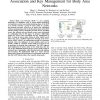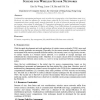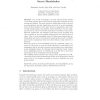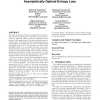34 search results - page 6 / 7 » Authenticated Group Key Agreement and Friends |
INFOCOM
2010
IEEE
13 years 2 months ago
2010
IEEE
Body Area Networks (BAN) is a key enabling technology in E-healthcare such as remote health monitoring. An important security issue during bootstrap phase of the BAN is to securely...
CORR
2010
Springer
13 years 3 months ago
2010
Springer
Traditional key management techniques, such as public key cryptography or key distribution center (e.g., Kerberos), are often not effective for wireless sensor networks for the se...
ACNS
2006
Springer
13 years 11 months ago
2006
Springer
In a society increasingly concerned with the steady assault on electronic privacy, the need for privacy-preserving techniques is both natural and justified. This need extends to t...
STOC
2010
ACM
13 years 8 months ago
2010
ACM
We study the problem of "privacy amplification": key agreement between two parties who both know a weak secret w, such as a password. (Such a setting is ubiquitous on th...
WCC
2005
Springer
13 years 10 months ago
2005
Springer
A secret handshake mechanism allows two entities, members of a same group, to authenticate each other secretly. This primitive was introduced recently by Balfanz, Durfee, Shankar, ...




